



Table of Contents
- Introduction to Marble Inlay Flooring
- Historical Significance in India
- The Artistry Behind the Craft
- Popular Marble Inlay Designs
- Materials Used in Marble Inlay
- Process of Creating Marble Inlay Flooring
- Applications in Modern Interiors
- Benefits of Marble Inlay Flooring
- Maintenance and Care
- Leading Marble Inlay Artisans and Manufacturers in India
- Cost Considerations
- Conclusion
- Faq's
Marble inlay flooring, an exquisite art form that seamlessly blends luxury with craftsmanship, has been an integral part of India's architectural heritage for centuries. This intricate technique involves embedding meticulously cut and polished pieces of marble, along with semi-precious stones, into a marble base to create elaborate designs and patterns. From the opulent corridors of the Taj Mahal to contemporary luxury residences, marble inlay flooring continues to captivate with its timeless elegance and intricate detailing.
Introduction to Marble Inlay Flooring
Marble inlay flooring, also known as Parchin Kari in the Indian subcontinent, is a decorative art form where artisans insert precisely cut and polished stones into a marble base, creating intricate patterns and images. This technique, which reached its zenith during the Mughal era, is renowned for its elaborate designs and the use of vibrant, contrasting colors.
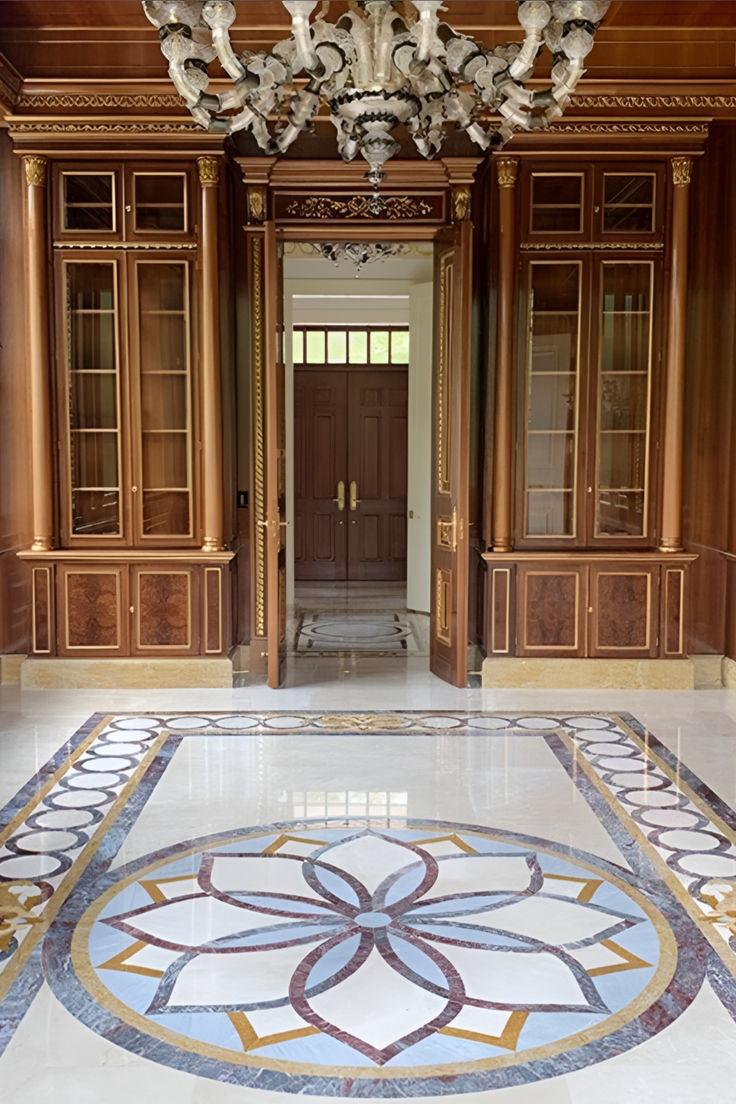 Custom Marble Inlay Flooring, Pinterest
Custom Marble Inlay Flooring, Pinterest
Historical Significance in India
The origins of marble inlay in India can be traced back to the 17th century, with the construction of the Taj Mahal in Agra being one of the most iconic examples. Commissioned by Mughal Emperor Shah Jahan, the Taj Mahal showcases extensive use of marble inlay, featuring intricate floral and geometric patterns embedded with semi-precious stones. This masterpiece not only exemplifies the zenith of Mughal architecture but also highlights the rich tradition of marble craftsmanship in India.
Over the centuries, this art form has been preserved and passed down through generations, with artisans continuing to create stunning inlay work in various architectural marvels across the country.
Also Read: Carpet Flooring Tiles Simplified: Benefits, Types, and How to Install
The Artistry Behind the Craft
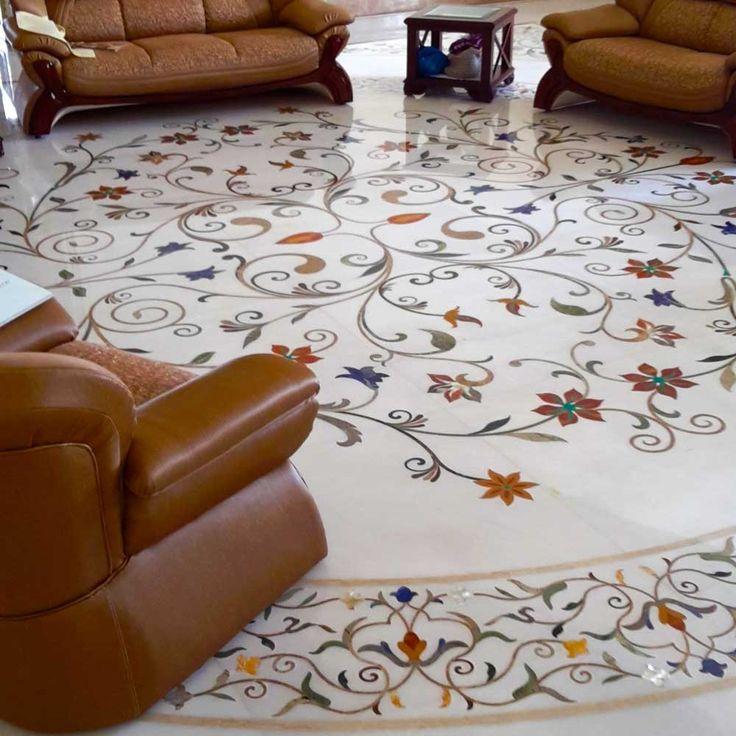 Marble Inlay Artistry, Pinterest
Marble Inlay Artistry, Pinterest
The creation of marble inlay flooring is a labor-intensive process that demands precision, patience, and unparalleled skill. Artisans begin by conceptualizing a design, often drawing inspiration from nature, geometry, or traditional motifs. Once the design is finalized, the marble base is carefully carved to create grooves, into which the stones will be inlaid.
Each stone is meticulously selected, cut, and shaped to fit perfectly into the carved marble. The stones are then polished to achieve a seamless finish, resulting in a harmonious blend of colors and patterns that bring the design to life.
Popular Marble Inlay Designs
Marble inlay flooring offers a plethora of design possibilities, catering to diverse aesthetic preferences. From intricate floral patterns to regal medallions, each design brings a unique charm to interiors. Here are some of the most sought-after designs:
- Floral Motifs:
Inspired by nature, floral inlay designs bring a sense of harmony and elegance to any space. These patterns typically feature delicately crafted flowers, leaves, and vines intertwined in artistic formations. Popular floral themes include roses, lotuses, and jasmine motifs, which are often seen in Mughal architecture. These designs add a soft, organic appeal to living rooms, hotel lobbies, and religious spaces.
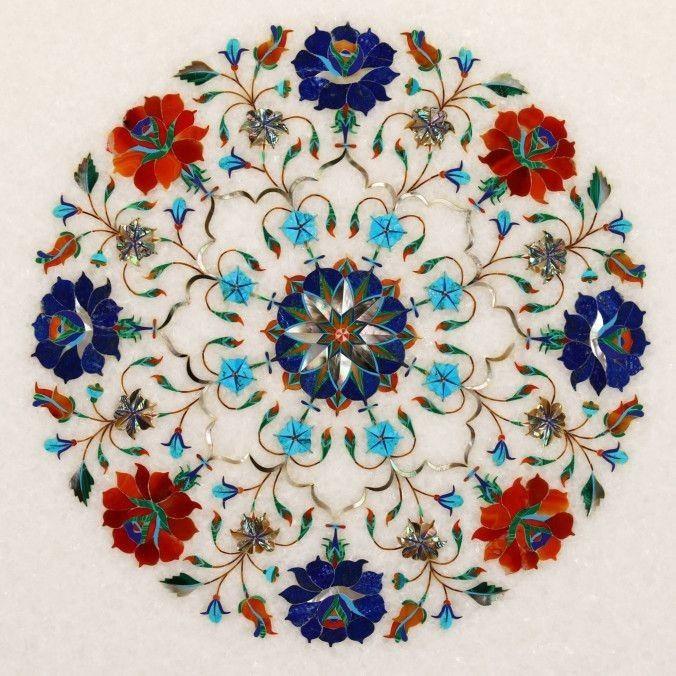 Floral Motifs, Pinterest
Floral Motifs, Pinterest
- Geometric Patterns:
Geometric inlay designs create a sleek and sophisticated look, making them a popular choice for both modern and traditional interiors. Using precisely cut pieces of marble, artisans create repeating patterns with hexagons, diamonds, squares, and triangles. These symmetrical designs are ideal for large halls, foyers, and contemporary office spaces, offering a seamless, structured aesthetic.
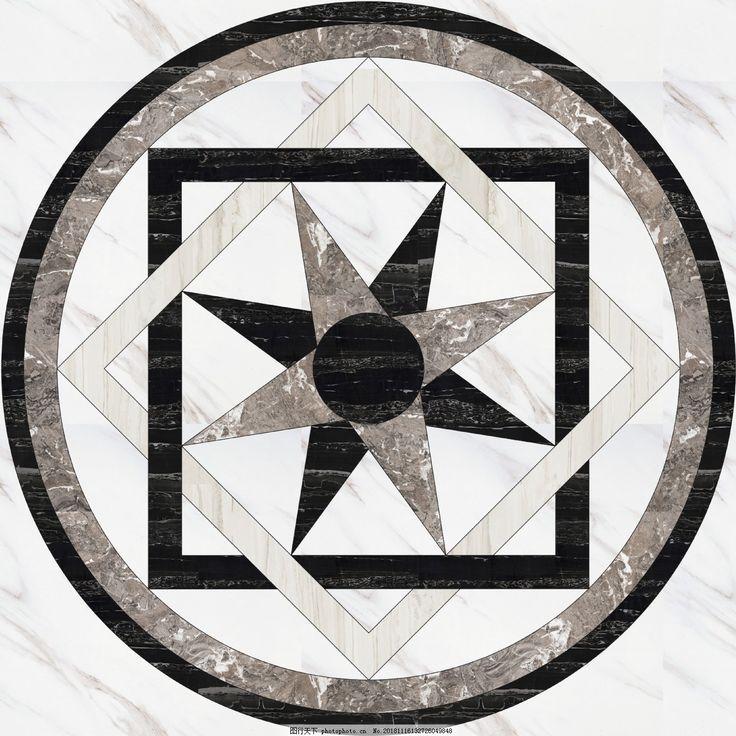 Geometric Patterns, Pinterest
Geometric Patterns, Pinterest
- Medallions:
A grand statement piece, marble inlay medallions serve as the focal point of a room. These designs often feature circular or oval patterns enriched with intricate floral, geometric, or abstract detailing. They are commonly placed in entryways, reception areas, and under grand chandeliers to enhance visual appeal. Some medallions also incorporate semi-precious stones, adding an opulent touch to the flooring.
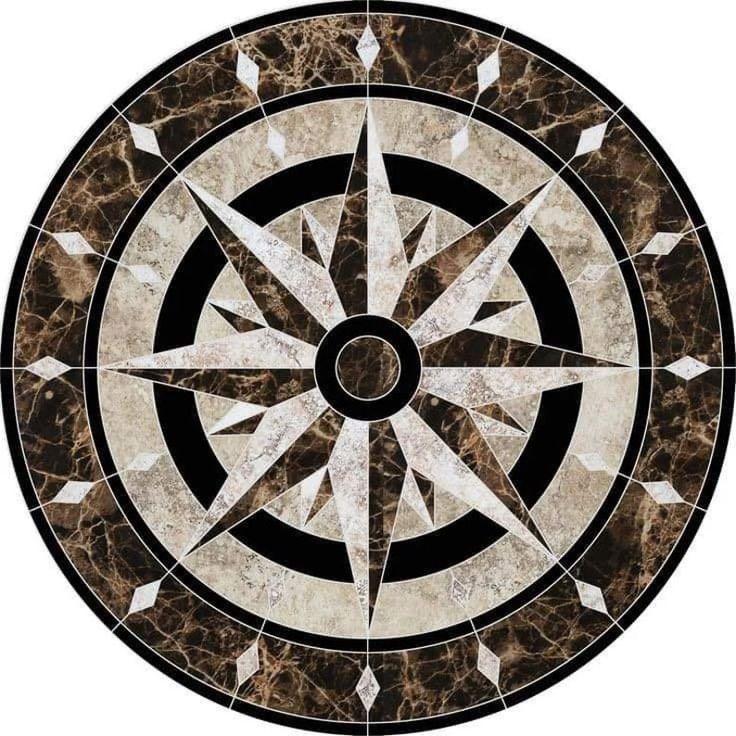 Medallions, Pinterest
Medallions, Pinterest
- Animal Figures:
Animal-themed marble inlays showcase the beauty of fauna through intricate craftsmanship. Designs featuring peacocks, symbolizing grace and beauty, elephants, representing strength and prosperity, and birds, which add a sense of movement, are quite popular. These patterns are frequently used in heritage properties, luxury hotels, and bespoke home interiors to create a regal atmosphere.
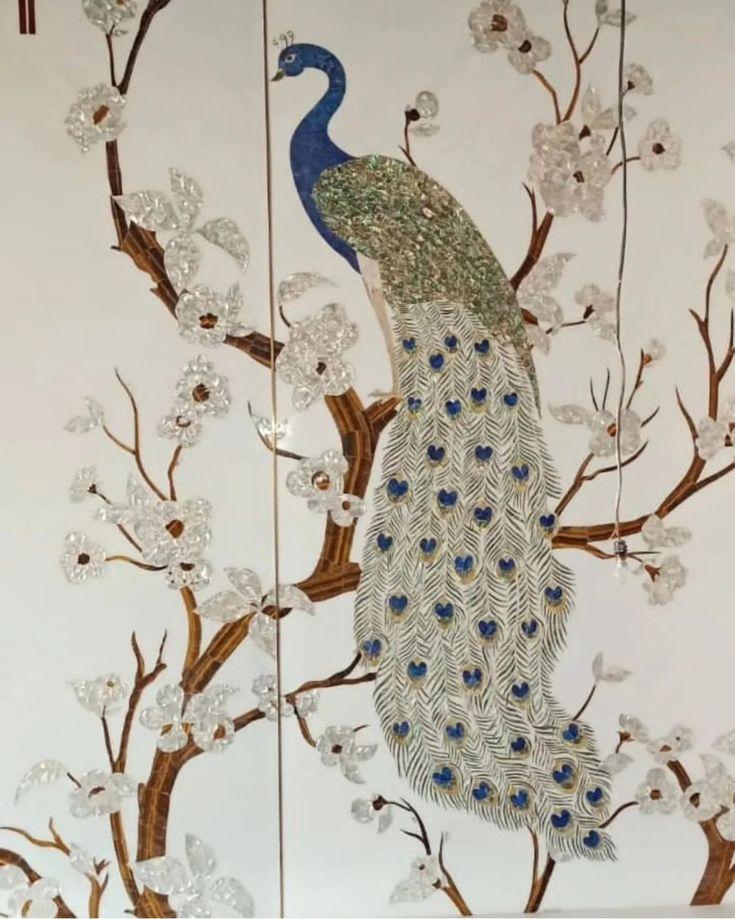 Animal Figures, Pinterest
Animal Figures, Pinterest
- Compasses and Stars:
Compass rose and star patterns hold cultural and symbolic significance, often representing guidance, direction, and cosmic harmony. These designs are frequently seen in grand entrances, palaces, and religious sites, where they add depth and historical significance to the flooring. The precise alignment of contrasting marble shades makes these designs visually striking, creating a sense of grandeur in any setting.
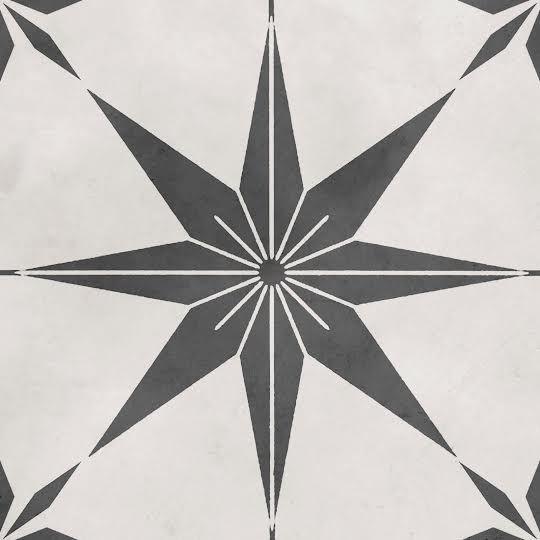 Star, Pinterest
Star, Pinterest
Materials Used in Marble Inlay
The beauty of marble inlay flooring lies in the harmonious combination of various materials. Commonly used stones and materials include:
- Marble:
Serving as the primary base material, marble provides both strength and elegance to the inlay flooring. Different types of marble are used based on their quality, durability, and aesthetic appeal. Some of the most popular varieties include: - Makrana Marble: Renowned for its pure white hue and long-lasting nature, this marble was famously used in the construction of the Taj Mahal.
- Italian Marble: Known for its high gloss finish and luxurious appearance, varieties like Statuario and Botticino are often preferred for high-end interiors.
- Indian Green Marble: Extracted from Rajasthan, this variety is often used for contrasting patterns and to add depth to inlay designs.
- Black Marquina Marble: A striking choice for modern interiors, this black marble enhances the vibrancy of inlaid stones, making the patterns stand out.
- Semi-Precious Stones:
These stones add vibrant colors, intricate details, and an element of luxury to the inlay designs. Carefully selected and hand-cut, they enhance the depth and richness of the patterns. Some widely used semi-precious stones include: - Lapis Lazuli: A deep blue stone that adds an eye-catching contrast to white marble, often used for celestial or floral designs.
- Malachite: A rich green stone with natural swirling patterns, perfect for leaf and vine motifs.
- Turquoise: A bright blue-green stone that enhances floral and geometric designs, creating a stunning visual appeal.
- Mother of Pearl: This iridescent material adds a subtle shimmer to the flooring, often used in delicate floral inlays.
- Coral: Known for its striking red-orange hue, coral is used in vibrant floral or abstract designs.
- Other Stones:
In addition to semi-precious stones, several other natural stones are incorporated to enhance the visual appeal and complexity of the inlay patterns. These include: - Onyx: Available in multiple shades, onyx is often used to create unique, translucent effects in marble inlay work.
- Jasper: Known for its earthy tones, jasper complements floral and landscape-inspired inlay designs.
- Agate: A popular choice for its naturally patterned and colorful variations, agate adds intricate detailing and contrast to designs.
- Sandstone: Used occasionally to introduce texture and a rustic feel to inlay work, especially in traditional settings.
- Granite: Though not as commonly used, granite adds durability and is preferred in areas with heavy foot traffic.
Also Read: 20 Marble Floor Design Ideas for Your Home in 2025
Process of Creating Marble Inlay Flooring
The creation of marble inlay flooring is a meticulous and labor-intensive process that requires exceptional skill and precision. Each step contributes to the final masterpiece, ensuring that the design is both aesthetically appealing and structurally sound. Below is a step-by-step breakdown of the process:
- Design Conceptualization:
The first step involves creating a detailed sketch of the intended design. Artisans draft intricate patterns, often drawing inspiration from floral motifs, geometric shapes, or historical themes. The design is carefully planned to ensure symmetry, balance, and seamless integration with the flooring space. Traditional methods use paper stencils, which are later transferred onto the marble slab for precision.
- Selection of Materials:
Once the design is finalized, the next step is choosing the appropriate materials. The type of marble used for the base must be of high quality, with minimal imperfections to ensure durability. Artisans then select semi-precious stones and other materials based on their color, texture, and compatibility with the design. Factors such as contrast, durability, and aesthetic appeal are considered to create a visually stunning and long-lasting inlay.
- Carving the Marble Base:
The marble slab is then carefully carved to create grooves that match the pattern of the design. Skilled craftsmen use chisels, drills, and other tools to delicately carve out the intricate shapes. Precision is crucial at this stage to ensure that the inlaid stones fit perfectly within the carved sections. The depth of the carving depends on the thickness of the stones being embedded, ensuring a level surface once the inlay is complete.
- Cutting and Shaping Stones:
After the base is prepared, the selected stones are cut and shaped with high precision. Using traditional hand tools and advanced cutting techniques, artisans meticulously shape each stone piece to fit seamlessly into the corresponding groove. This process requires immense patience and accuracy, as even the slightest misalignment can affect the overall design. Once shaped, the stones are polished to enhance their natural color and smoothness before being placed into the marble base.
- Inlaying the Stones:
Once the stones are cut and prepared, they are carefully placed into the carved grooves. A special adhesive or a mix of natural glue and resin is used to secure the stones firmly in place. Artisans press each piece tightly to ensure a snug fit and prevent gaps. This step demands precision, as even minor adjustments can impact the symmetry and flow of the design. The stones are arranged in layers, ensuring a uniform and cohesive look throughout the flooring.
- Polishing:
The final step in the process is polishing the entire surface to create a smooth, seamless finish. Artisans use fine abrasives and polishing tools to bring out the natural shine of the marble and the inlaid stones. The polishing process enhances the vibrancy of the colors, highlights the intricate details, and ensures a flawless, glossy surface. In some cases, additional sealing is applied to protect the flooring from stains, moisture, and wear over time.
Applications in Modern Interiors
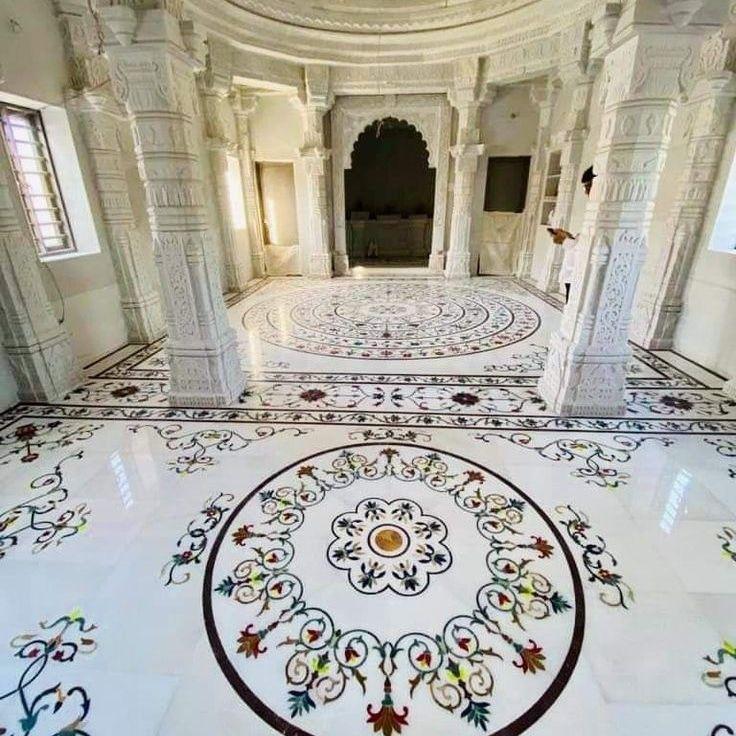 White Marble Inlay Flooring work, Pinterest
White Marble Inlay Flooring work, Pinterest
While rooted in tradition, marble inlay flooring has found its place in contemporary interior design. Its applications include:
- Residential Spaces: Living rooms, dining areas, and foyers adorned with marble inlay flooring exude luxury and sophistication.
- Commercial Establishments: High-end restaurants, luxury boutiques, and premium retail stores use marble inlay flooring to create an upscale ambiance. The intricate designs add a touch of opulence, enhancing the shopping or dining experience.
- Hotels and Resorts: Luxury hotels and high-end resorts use marble inlay flooring to create a regal ambiance in lobbies, corridors, and banquet halls.
- Religious Places: Temples, mosques, and churches incorporate intricate inlay work to enhance the divine aesthetic of their interiors.
- Government Buildings and Palaces: Prestigious establishments such as Rashtrapati Bhavan and other historical sites showcase elaborate marble inlay designs to reflect India's rich cultural heritage.
- Corporate Offices: High-end corporate spaces use marble inlay flooring in boardrooms, reception areas, and hallways to create a sophisticated work environment.
Also Read: What is Makrana Marble? - Properties, Comparison, Applications
Benefits of Marble Inlay Flooring
Marble inlay flooring is highly sought after due to its numerous advantages:
- Timeless Elegance: Its luxurious appeal never goes out of style, making it a valuable long-term investment.
- Durability: Marble is a strong, long-lasting material that withstands high foot traffic and remains intact for decades.
- Customization: Designs can be tailored to personal preferences, allowing homeowners to create unique and artistic flooring.
- Eco-Friendly: As a natural material, marble is sustainable and does not emit harmful chemicals.
- High Property Value: Homes featuring marble inlay flooring tend to have higher resale values due to their opulent aesthetic.
Maintenance and Care
While marble inlay flooring is durable, it requires proper maintenance to preserve its beauty:
- Regular Cleaning: Use a soft cloth and mild detergent to clean the surface. Avoid acidic cleaners that can damage the marble.
- Sealing: Apply a marble sealer periodically to prevent staining and moisture absorption.
- Avoid Heavy Impact: While marble is strong, sharp or heavy objects can cause chipping or cracks.
- Polishing: Professional polishing enhances the shine and smoothness of the flooring, maintaining its elegance over time.
- Use Protective Mats: Placing mats at entry points can prevent dirt accumulation and reduce wear and tear.
Also Read: Laminate Flooring: A Versatile and Cost-Effective Solution for Homes
Leading Marble Inlay Artisans and Manufacturers in India
Several regions in India specialize in marble inlay work, with artisans preserving this traditional craft:
- Agra: The epicenter of marble inlay craftsmanship, Agra is home to skilled artisans who create stunning inlay flooring, often inspired by the Taj Mahal.
- Jaipur: Known for its vibrant designs, Jaipur's marble inlay artisans blend Rajasthani heritage with modern aesthetics.
- Udaipur: The city of lakes is renowned for its white marble and intricate inlay artistry.
- Makrana: This region supplies high-quality marble used in numerous historical monuments, including the Taj Mahal.
Reputed companies offering marble inlay flooring include:
- Rameshwaram Arts & Crafts: Specializes in customized inlay work.
- Stone Mart India: Known for premium marble inlay products.
- Agra Marble Emporium: Offers authentic handcrafted inlay designs.
- A-Class Marble: Supplies high-quality marble and intricate inlay flooring solutions.
Cost Considerations
The price of marble inlay flooring varies based on several factors:
- Type of Marble: Premium varieties like Makrana and Italian marble are more expensive.
- Design Complexity: Highly detailed and intricate designs require more labor, increasing costs.
- Stone Inlay Selection: Semi-precious stones like lapis lazuli, turquoise, and mother of pearl elevate the price.
- Labor Costs: Skilled artisans command higher fees for their craftsmanship.
Estimated Price Range
- Basic Designs: ₹1,500 - ₹3,000 per sq. ft.
- Mid-Range Designs: ₹3,000 - ₹6,000 per sq. ft.
- High-End Custom Work: ₹6,000+ per sq. ft.
Conclusion
Marble inlay flooring is a symbol of luxury and artistic finesse, deeply rooted in India's architectural history. With its intricate designs, durability, and timeless elegance, it continues to be a preferred choice for homeowners, architects, and designers. Whether enhancing a traditional palace or modern luxury home, marble inlay flooring offers a touch of sophistication that elevates any space. While it requires careful maintenance and a considerable investment, its aesthetic and monetary value make it a worthwhile choice for those who appreciate fine craftsmanship.
explore further
Latest from Contemporary ideas
More from Innovations
Resources
Dwello, for every home buyer, is a way to go from 'I feel' to 'I know', at no extra cost.




